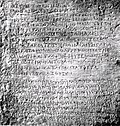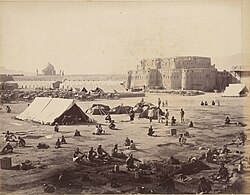Kandahar

Kandahar (Pashto: کندهار) is the second largest city in Afghanistan.[1] Alexander the Great visited the town and named it after himself. Alexander the Great founded Kandahar in the 4th century BC. He called it "Alexandria Arachosia".[2] About 500,000 people live there in 2015, the vast majority of whom are ethnic Pashtuns. It is in the central-south of Afghanistan.[3] Kandahar is the capital of Kandahar Province. It is an important trading centre for sheep, wool, cotton, silk, felt, food grains, fresh and dried fruit, and tobacco. Kandahar has an international airport.[3]
Kandahar Media
Kandahar Bilingual Rock Inscription (Greek and Aramaic) by Emperor Ashoka, from Chilzina in Kandahar, 3rd century BC.
A miniature from Padshahnama depicting the surrender of the Shia Safavid garrison at what is now Old Kandahar in 1638 to the Mughal army of Shah Jahan
The Mausoleum of Mirwais Hotak
Painting by Abdul Ghafoor Breshna depicting the 1747 coronation of Ahmad Shah Durrani, who is regarded as the founding father of Afghanistan (Father of the Nation).
British-Indian invading forces at Kandahar after the 1880 Battle of Kandahar, during the Second Anglo-Afghan War. The large defensive wall around the city was finally removed in the early 1930s by the order of King Nader Khan, the father of King Zahir Shah.
U.S. Army troops in 2009 passing by the starting point of the Army Ten-Miler run at their base next to Kandahar International Airport.
References
- ↑ Ryan, Chris (2009). Battleground (Code Red). Doubleday. p. 307. ISBN 9780385612999.
- ↑ "The Empire and Expeditions of Alexander the Great". World Digital Library. 1833. Retrieved 2013-07-26.
- ↑ 3.0 3.1 "Kandahār". Encyclopædia Britannica. Encyclopædia Britannica.







